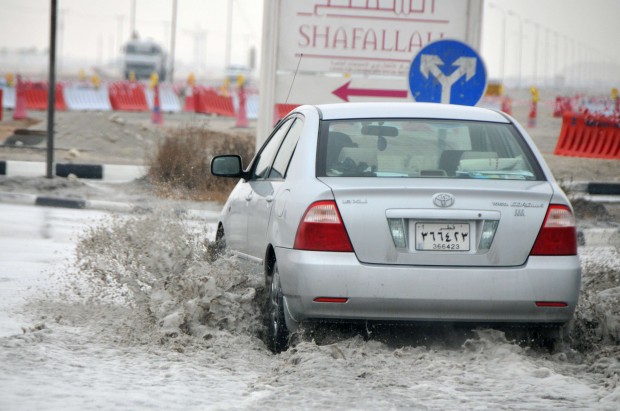Flooding brings Qatar to a near standstill

A car drives through a flooded street in Doha, capital of Qatar, Jan. 19, 2011. The continuous rain hit Qatar since monday, causing travel inconvenience for local residents. (Xinhua/Du Jian)
A year’s worth of rain deluged parts of Qatar on Wednesday 25 November as seasonal storms moving through Saudi Arabia flooded streets in a city northwest of the capital, Riyadh. The storm clouded over parts of the Arabian Peninsula, but struck Doha, the capital of Qatar, particularly hard.
At Hamad International Airport in Doha, the home of Qatar Airways, at least 79.5 millimeters (3.13 inches) of rain fell, according to the Qatar Meteorology Department. Despite that, officials at Hamad International said that flights were operating normally, but as the condition started getting worse some flights were delayed, according to Doha news. Typically, the hot, desert country sees around 50 millimeters (1.97 inches) of rain in a year, according to AP.
The rainwater flooded streets and shut down some stores and malls in Doha. Local media reported some schools and daycare centers closed early because of the downpour. Many residents have been stuck in a very slow moving traffic. The Ministry of Interior has even tweeted in its official Twitter account warning all residents to drive with caution and safety. It has further advised all residents to reduce speed and to keep a space between vehicles.
In Saudi Arabia, the state-run Saudi Press Agency said heavy rains and flooding struck the city of Buraydah, some 320 kilometers (200 miles) northwest of Riyadh, as well as the surrounding Qassem province. Saudi civil defense authorities posted photos online of their officers rescuing people by boat. Other social media images showed rushing water eating away at roads and cars stuck in the floodwaters. Countries of the Arabian Peninsula have seen rain in recent days as the seasons change across the Gulf, according to Saudi Gazette.
Public Works Authority (Ashghal) was said to have provided a surface and ground water drainage system in Qatar. Ashghal is the governing body responsible for the design, construction, delivery and maintenance of all major projects, including storm and rain water, waste water, and sewerage drainage and treatment across Qatar. But according to Ashghal, this is not a normal occurrence and that such heavy rains occur rarely in Qatar, pointing out that the “heavy and unprecedented” rains exceeded the capacity and design criteria for the drainage network.
The rise in the water level has been blamed on large-scale development and leaks from older infrastructure, alongside sea water intrusion. On that topic, Padraig Nagle, co-founder Action International Services, a company specializing in de-watering in Qatar, says: “There is a direct correlation between the growing population and the produced waste water for which there are currently few uses and, as such, the water is continuously been discharged inland.” He highlights how even Qatar’s geology plays a part: “The discharge of treated waste water saturates the upper sand layers and travels on top of the underlying rock surface towards the sea; this is the main cause of the water table rise that is being witnessed within the city of Doha,”
In other countries of the region similar floods occurred with possibly more damage, as in several Egyptian cities,as Alexandria and Al-Behera, where the infrastructure couldn’t handle a day of rain, flooding the cities and stopping life there. It was disastrous as it turned into a scene of death when water mixed with electricity, killing people through the past month. This sheds some light on the state on infrastructure in Middle Eastern countries, as some of their cities nearly collapsed after a couple of days rain, or even in Doha’s case, a couple of hours. Though there appears to be a drainage system in these countries, it looks like it’s not well-prepared or suited for heavy rain, which occasionally hits these countries, almost every winter.



















































